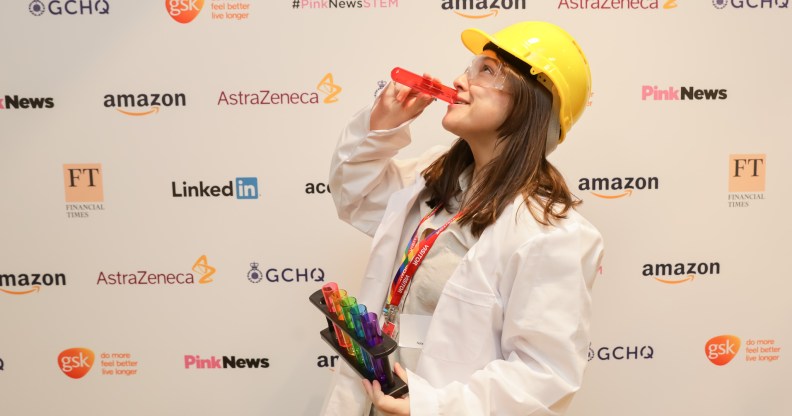Why do we need LGBT leadership in science, technology, engineering and mathematics?

Dozens of graduates packed the offices of Amazon for PinkNews’ 2020 LGBT Leaders Stem event. (Paul Grace)
This February, PinkNews, Amazon and glamazon partnered up for the LGBT Leaders: STEM 2020 conference.
The event addressed the under-representation of LGBT+ people in science, technology, engineering and mathematical roles, where guests took part in panel discussions and networking opportunities with LGBT leaders in their field from organisations like Amazon, Accenture, the Financial Times and LinkedIn.
Pharmaceutical companies like GlaxoSmithKline and AstraZeneca also hosted a session together as members of the Proud Science Alliance.
Why do we promote LGBT leadership in STEM?
We want to challenge and change the fear that LGBT+ people experience all too often in the workplace.
The evidence stacks up: More than a third of LGBT employees across all industries have felt the need to conceal their sexual orientation at work.

(Paul Grace)
The UK government’s latest National LGBT+ Survey also highlighted a range of issues for LGBT+ people in the workplace, from lower life satisfaction than the national average, to fears over negative reactions and verbal or physical harassment.
Part of our response is to work across industries, organisations, government bodies and the education sector to help the next generation do things differently.
What are the benefits to employers and industries of promoting LGBT+ leadership?
The link between diversity of thought and innovation is very well understood these days by businesses. In simple terms, diverse teams are better prepared to innovate on behalf of customers – and that can positively impact an organisation’s bottom line.
If you’re developing a product or service that will be used by millions of customers, it makes sense to have a diverse group of people involved in developing it.

(From L-R): PinkNews CEO, Benjamin Cohen, Monzo CTO Meri Williams and Wellcome Trust strategy director Ed Whiting. (Paul Grace)
That means you can innovate more efficiently and will be closer to achieving an inclusive and accessible product.
If a business is clear in expressing its support for LGBT+ employees, it can also help to make all employees feel comfortable and confident and, as we know, happy employees tend to be more productive.
Building an inclusive company culture also benefits retention and recruitment.
By creating more opportunities for people of all backgrounds, you’re more likely to attract and keep the best possible candidates. Having LGBT+ representation in leadership roles will show that progression is possible.
How can organisations change or evolve their culture?
Firstly, it’s about implementing a working culture, day-to-day practices and robust processes that underpin diversity and inclusion within an organisation. That means senior leaders buying into and voicing the importance of inclusivity – those values have to come from the top.
You should show support for equality and inclusion of everybody. While it is important to express support to those that are ‘out’, you should not neglect those that might not yet be ready to share their sexuality. Businesses should also remember that “LGBT+” is an umbrella term and should acknowledge the unique experiences and challenges faced by each community.
Having strong employee support systems is key.

(Paul Grace)
As chair of glamazon, Amazon’s affinity group for LGBT+ employees, I’ve seen first-hand how the group can support its members and positively impact the wider business. Creating an employee group will give those groups a voice providing a sense of empowerment and trust.
Creating ways for allies to support their colleagues is also important. From small things such as rainbow lanyards to regular networking events and anything else besides – you’ll find that colleagues are happy to be loud and proud as allies.
Remember that small adaptations can also have a big impact. At Amazon, those adaptations include updated company guidelines for transgender employees and changing our internal phonetool so employees can share their preferred pronouns.
How can individuals working in STEM make a difference?
If you’re like me and already working in a STEM-related career and wish to make a difference, there’s so much you can do.
At a basic level, taking the time to mentor junior colleagues – either formally or informally – can be invaluable. Even if it’s just a coffee and a chat once a week.
Speaking at events and through external media or internal channels will also raise your voice above the noise. Use them as a platform to challenge the industries where you see problems.
How can we increase LGBT visibility in STEM?
Don’t limit visibility to just awareness days! There are plenty of national awareness days, weeks and months, which help to increase public understanding, but companies need to be consistent and vocal about their backing of LGBT+ employees throughout the year.
External communication is also vital.
Too often we come across preconceptions of STEM careers as being for white, middle class and male candidates – but that couldn’t be further from the truth.
The way we present STEM-related careers feeds into those preconceptions, and a range of organisations like the Royal Academy of Engineering are working to tackle that image.
Think big! Bold initiatives can make a real difference and also inspire other companies to drive change.
For example, over the last year glamazon, PinkNews and Just Like Us partnered up on the LGBT+ Reading Roadshow, delivering free inclusivity workshops and books on LGBT+ themes to secondary schools around the UK.
Feedback from staff and students has been incredible!
These changes add up to an environment where LGBT+ employees are not only visible within STEM-related careers, but will also benefit from an environment and culture that will help them flourish in leadership roles. That will encourage important and positive change for the future!

